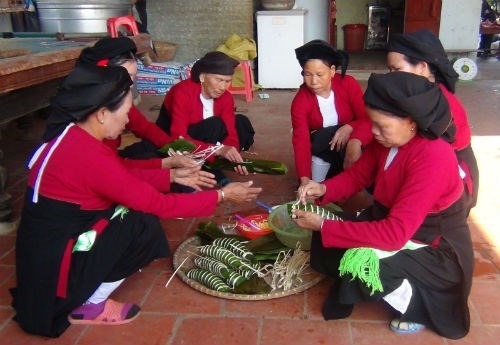 |
|
San Diu people in Bac Giang prepare for Tet |
The group considers Tet an occasion for familymembers to gather after a year of hard work. To welcome the new year, San Diupeople decorate their homes with red papers stuck on ancestor altars, entrancedoors, gates and perennial trees in their gardens in the belief that red paperswill bring in fortune and happiness for not only their own families but thecommunity and other living creatures as well.
While eating simple food like vegetable, bambooshoot, taro and bean everyday, the San Diu prepares numerous dishes for Tet,including fried pork, fried duck, banh tay (long sticky rice cake with greenbean and pork filling), banh gio (cake made from stick rice soaked in forestleaf liquid and served with honey) and sour meat.
About one week before Tet, San Diu families buyfood or kill pigs to make Tet dishes which can be reserved for as long as onemonth as the group has good food preservation methods.
At the Tet fair which is held right before Tet,San Diu women sell their self-made products such as peanuts, beans, chickensand ducks to buy domestic utensils and new clothes for children and elderlypeople.
During Tet, the San Diu wear beautiful costumes.A man wears a black five-panel shirt long down to the knees, which is buttonedon the right, and white or brown trousers with wide and straight legs, longcrotch and broad upper hems. He also wears a shorter white shirt inside. Awoman’s costume includes a headdress, a brown bodice, a short brown blouse,which is buttoned to the collar and has two small pockets on the flaps, afour-panel knee-length dress with the upper part in brown and the lower part inblack, which can be either buttoned or not, and a black long skirt. The costumeis completed with leggings and slippers or wood clogs.
On the New Year’s Eve, the San Diu make anoffering meal for their ancestors, praying for their blessing for a lucky andprosperous new year. The offerings include a chicken or a piece of boiled pork,a bottle of wine, fruits and Tet cakes.
On the first day of the lunar New Year, San Diufamilies eat porridge served with minced meat and spring onion. After the NewYear meal, children wish their parents good health and elderly people givelittle kids lucky money. After that, men visit relatives and villagers to giveNew Year wishes. Women can go out but are not supposed to visit any families sothey often stay at home to receive guests.
On the first and second days of Tet, San Diupeople are not supposed to dump rubbish, which is only swept into a corner oftheir houses. Rubbish disposal during Tet is believed to deny the family ofgood fortune throughout the year. Only on the third day, they put rubbishtogether with a piece of banh tay and a burning incense in a basket and dump itunder a big tree in the village in the belief that hungry evil spirits aredriven out of their homes.
On the second day of the new year, every San Diufamily prepares a hearty meal for offering to ancestors. The meal includesdifferent dishes made from chicken and pork and five bowls of banh troi(scalded round sticky rice cake with brown sugar filling). After the offeringritual, the family shares the meal with relatives and guests.
During Tet, San Diu young people sing soong co,a kind of singing exchange between boy and girl groups. In this typical folk art of the group, young men and women sing songs about their villages, ancestors,friendship and love. From the second day of Tet onward, young peoplemeet and sing all day long and even throughout the night. Those having amorousintentions separately sing in couples to get to know about each other and theirfamilies. Soong co songs, which cover different topics from spring welcome,celebration of New Year, new home and wedding, to friend-making and love, canbe sung for weeks and even for months till the end of spring./.VNA
 The San Diu ethnic minority group, who live in northern mountainous areas with a population of nearly 147,000, celebrate quite a lot of festivals the most important of which is Tet, the lunar New Year festival.
The San Diu ethnic minority group, who live in northern mountainous areas with a population of nearly 147,000, celebrate quite a lot of festivals the most important of which is Tet, the lunar New Year festival.